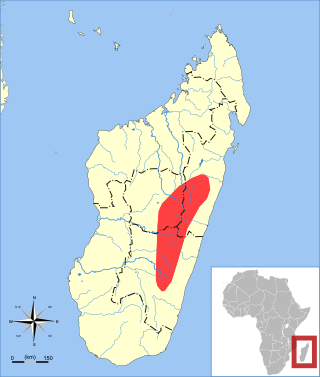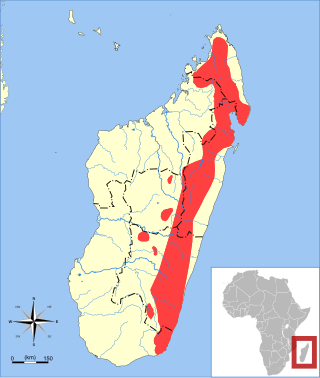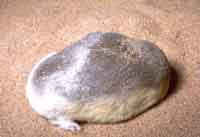
Moles are small mammals adapted to a subterranean lifestyle. They have cylindrical bodies, velvety fur, very small, inconspicuous eyes and ears, reduced hindlimbs, and short, powerful forelimbs with large paws adapted for digging.

Placental mammals are one of the three extant subdivisions of the class Mammalia, the other two being Monotremata and Marsupialia. Placentalia contains the vast majority of extant mammals, which are partly distinguished from monotremes and marsupials in that the fetus is carried in the uterus of its mother to a relatively late stage of development. The name is something of a misnomer considering that marsupials also nourish their fetuses via a placenta, though for a relatively briefer period, giving birth to less developed young which are then nurtured for a period inside the mother's pouch.

The order Insectivora is a now-abandoned biological grouping within the class of mammals. Some species have now been moved out, leaving the remaining ones in the order Eulipotyphla within the larger clade Laurasiatheria, which makes up one of the basal clades of placental mammals.

Golden moles are small insectivorous burrowing mammals endemic to Sub-Saharan Africa. They comprise the family Chrysochloridae and as such they are taxonomically distinct from the true moles, family Talpidae, and other mole-like families, all of which, to various degrees, they resemble as a result of evolutionary convergence. There are 21 species. Some are relatively common, whereas others are rare and endangered.

A tenrec is any species of mammal within the afrotherian family Tenrecidae, which is endemic to Madagascar. Tenrecs are a very diverse group; as a result of convergent evolution some resemble hedgehogs, shrews, opossums, rats, and mice. They occupy aquatic, arboreal, terrestrial, and fossorial environments. Some of these species, including the greater hedgehog tenrec, can be found in the Madagascar dry deciduous forests. However, the speciation rate in this group has been higher in humid forests.
Lipotyphla is a formerly used order of mammals, including the members of the order Eulipotyphla as well as three other families of the former order Insectivora, Chrysochloridae, Tenrecidae (tenrecs), and Potamogalidae. However, molecular studies found the golden moles, tenrecs, and otter shrews to be unrelated to the others. This made Lipotyphla an invalid polyphyletic order and gave rise to the notion of Eulipotyphla instead, an exclusively laurasiathere grouping.

The web-footed tenrec, Malagasy otter shrew, or aquatic tenrec is the only known semiaquatic tenrec, and is found in eastern Madagascar, especially in and around Ranomafana National Park. It grows to between 25 and 39 cm, and was once thought to be extinct. It feeds on crabs, aquatic insects, and crayfish. The population is considered vulnerable. It was formerly placed in the monotypic genus Limnogale, but has been moved to Microgale based on molecular data showing it to be deeply nested within the latter.

The Afroinsectiphilia is a clade that has been proposed based on the results of recent molecular phylogenetic studies. Many of the taxa within it were once regarded as part of the order Insectivora, but Insectivora is now considered to be polyphyletic and obsolete. This proposed classification is based on molecular studies only, and there is no morphological evidence for it.

Soricomorpha is a formerly used taxon within the class of mammals. In the past it formed a significant group within the former order Insectivora. However, Insectivora was shown to be polyphyletic and various new orders were split off from it, including Afrosoricida, Macroscelidea, and Erinaceomorpha, with the four remaining extant and recent families of Soricomorpha shown here then being treated as a separate order. Insectivora was left empty and disbanded.
Amblysomus is a genus of the golden mole family, Chrysochloridae, comprising five species of the small, insect-eating, burrowing mammals endemic to Southern Africa. All five species can be found in South Africa and some are also found in Eswatini and Lesotho.
Microgale is a genus of mammal in the family Tenrecidae. There are 21 living species on the island of Madagascar and one extinct species known from a fossil. Some species have been discovered in the last twenty years.

Dobson's shrew tenrec is a species of mammal in the family Tenrecidae. It is endemic to Madagascar. Its natural habitats are subtropical or tropical moist forests, plantations, and heavily degraded former forest. On the basis of molecular data indicating that it and Talazac's shrew tenrec form a sister group to the rest of Microgale, these two species were transferred from Microgale to Nesogale in 2016.

The mole-like rice tenrec, also known as the fossorial tenrec or hova rice tenrec, is a species of mammal in the tenrec family. Like all other tenrecs, it is endemic to Madagascar. Its natural habitats are subtropical or tropical moist forests, swamps, freshwater lakes, and irrigated or seasonally flooded agricultural land.
Oryzorictinae is a subfamily of tenrecs endemic to the island of Madagascar. It is the largest of three tenrec subfamilies. Oryzorictinae is thought to have split from the lineage of its closest relative, Geogale, about 30 million years (Ma) ago. The deepest phylogenetic split within the subfamily, that between Oryzorictes and a clade composed of Microgale plus Nesogale, is thought to have occurred about 28 Ma ago. In turn, Microgale and Nesogale are thought to have diverged about 19 Ma ago.
Nesogale is a genus of tenrecs, which are a family of afrotherian mammals endemic to Madagascar. On the basis of molecular data indicating its two species form a sister group to the rest of Microgale, they were transferred from Microgale to Nesogale in 2016, thus resurrecting a genus first erected by Oldfield Thomas in 1918. These genera, along with Oryzorictes, form the tenrec subfamily Oryzorictinae. Nesogale contains the following species:









